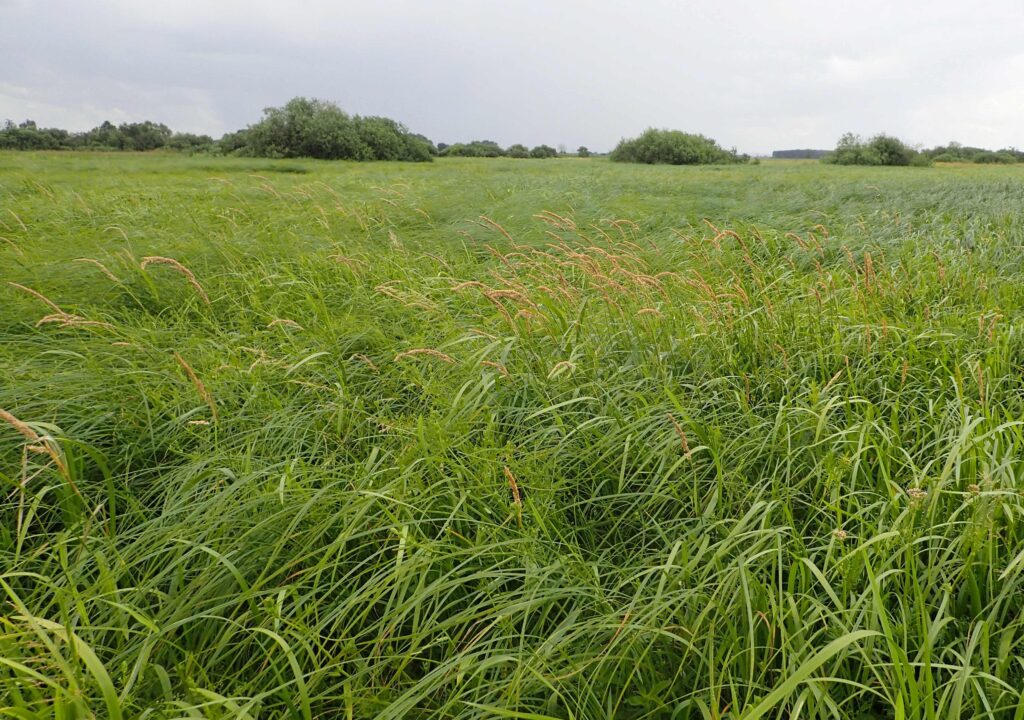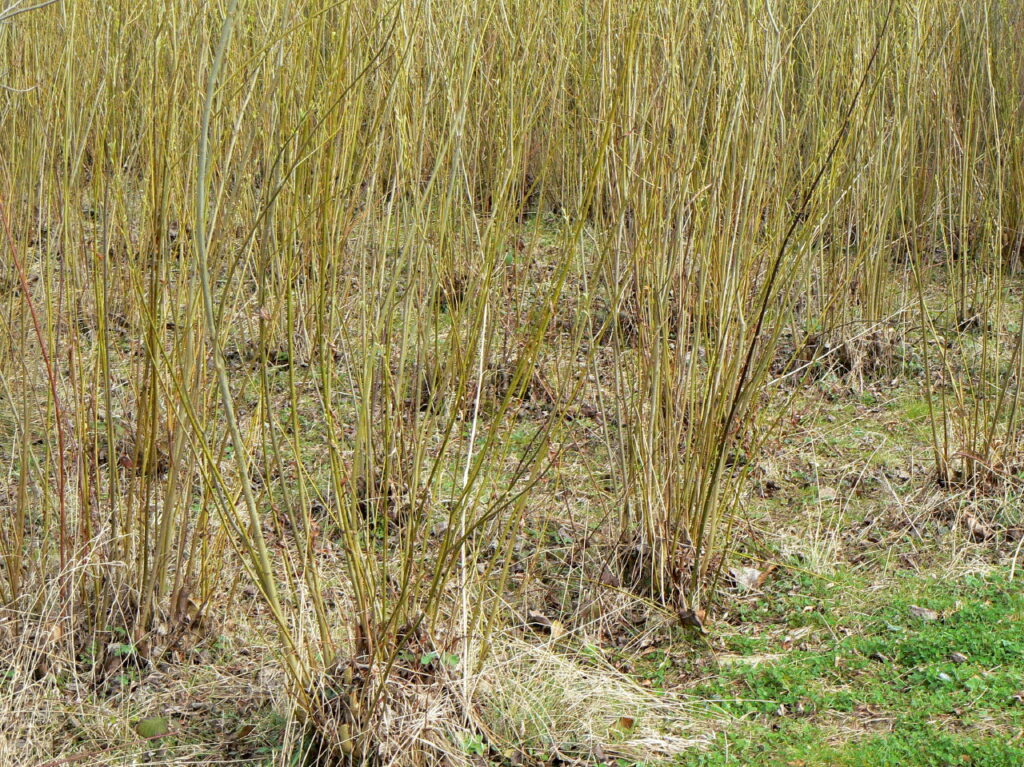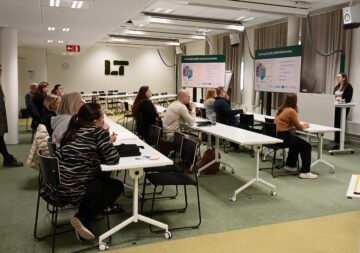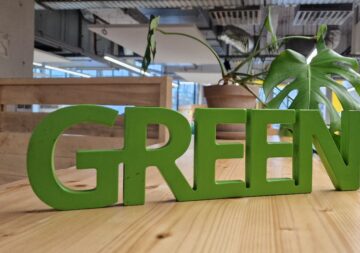
Reed canary grass (RCG) and willow were popular energy crops 15-20 years ago. Today they are considered as potential sustainable biomasses for various utilisation possibilities. Both are studied as potential feedstocks for high value biocarbon products in joint research project of LAB and VTT.
Author: Eliisa Punttila
High-value biochar from agricultural feedstocks
Suitability of agricultural biomasses as feedstocks for high value biocarbon products used in different applications, in energy storage, water purification and biocomposites, is studied in a joint research project of VTT and LAB, BioCarbonValue (2023–2024), co-funded by Business Finland (BioCarbonValue 2024). In the project, reed canary grass (RCG) and willow were selected among the most interesting feedstocks for carbonization tests. This article aims to describe their availability and current utilization practices.
Reed canary grass
Reed canary grass (RCG, Phalaris arundinacea L.) is a perennial grass crop. It is harvested annually in early spring and provides yields for 10-12 years. (Pahkala et al 2002, 5, 7.) The average yield in field experiments conducted in Finland, Latvia and Lithuania is around 6 t/ha, while the commercial yield (taking the harvest losses in account) is lower, 3.3-3.5 t/ha (Mola-Yudego et al 2021, 8). The annual yield in Finland in 2011–2017 was on average yield 3.2 t/ha, varying between 2.8 and 4.6 t/ha (LUKE 2023b).
Popularity of RCG cultivation has varied in Finland. The cultivation area was at the highest level 20 000 ha in 2008 (Lötjönen et al 2009, 14). At that time, RCG was regarded as promising bioenergy crop and the aim was to expand the area to 100 000 ha by 2015 (Finnish Ministry of Agriculture and Forestry 2007, 32 & 34). However, the cultivation area decreased due the challenges in energy use, high cultivation and transportation costs of RCG and changes in subsidy policies, (Kai 2022; Lötjönen 2015, 31; Vaara & Siponmaa 2013). The area decreased from 6600 ha to 2800 ha in 2013–2021, although the number of farms cultivating RCG have remained in around 300 (LUKE 2023a).
Also in Sweden, RCG is in commercial production and cultivation areas have varied during the recent decades. In 2020, the cultivation area was 550 ha (Mola-Yudeko et al 2021, 4). However, interest towards cultivation of RCG for energy purposes is arising in e.g. Poland (Kitczak et al 2023).
The RCG has been cultivated mainly for energy production (Pahkala et al 2002, 3). Other utilisation purposes of RCG have been investigated, for example in bioethanol production (Kallioinen et al 2012), biogas production (Laasasenaho et al 2020) and biocarbon production (Zemiri & Niu 2022). Currently, the RCG is considered as potential substitute for peat in bedding material and growing media (Kai 2022; Kurikka 2024; Manni & Huuskonen 2021). Fidelis et al (2023) studied chemical properties of RCG for biorefinement and found various bioactive compounds which may provide added value for utilisation of RCG.
Willow
Willow (Salix L.) is cultivated as short-rotation coppice. Willow varieties have been developed for decades to provide high yields in short time especially from the energy use point of view, and to provide different properties for utilisation in biorefinement, e.g. for medical purposes (Baker et al 2022, 1-2). The willow plantation will produce yields for 19-25 years, while the willow is harvested in every 3-5 years (Viherä-Aarnio, Jyske & Beuker 2022). According to a review made by Aro (2022, 22-23), the average annual yield of willow varies from 4 to 16 dry ton per hectare, depending on willow variety and clone, climate, soil, weather, and management practices. Mola-Yudego et al (2016) estimated with a spatial model the average yields in North Europe: depending on the region, it would be 4-5 tons per hectare.

Picture 1. Coppiced willow in England (Murray-Rust 2011. CC BY-SA 2.0)
According to Jylhä and Viherä-Aarnio (2022, 16), there is no exact information of the current cultivation areas of willow in Finland, but based on interviews, it is around 100 hectares. In Europe, Sweden leads the willow production. According to Xu and Mola-Yudego (2021, 5), the overall plantation area has been at highest 14 000 ha in Sweden, but in 2017 area was 7785 ha. Smaller areas have found in Denmark (4500 ha in 2015), Great Britain (4100 ha), Latvia (1500 ha) and Estonia (50 ha) (Heino & Hytönen 2016, according to Jylhä & Viherä-Aarnio 2022, 15). Willow plantations are found also from Germany and high expansion targets are noted in Poland and UK (Mola-Yudego et al (2016, 1093). Overall willow plantations area in Poland was 8000 ha in 2010 (Ben Fradj et al 2020, 6).
Baker et al (2022) summarised the potential value chains being developed from willow which can be used as a whole tree or by separated to bark and pulp; it is used in e.g. biofuel and bioenergy production, medical applications and biocomposites. Willow has a high lignocellulosic content and various bioactive compounds (Baker et. al 2022, 2-3). Willow can also be used in biochar production (Rasa, Jyske & Viherä-Aarnio (2022, 57-59).
An industrial scale multi-utilisation of willow is currently lacking markets, processes, and availability of feedstock in Finland. A willow-based biorefinery would require approximately 100 000 ha of willow plantations. (Maunuksela & Kilpeläinen 2022, 85.) However, willow is already used in commercial biochar production in Finland. Establishment of biochar plant using willow could be possible by perhaps 1600 ha plantation area (Mäntyranta 2017).
Conclusions and discussion
Both RCG and willow have been previously popular energy crops. Although there is no statistical information of their current cultivation areas, it is known that the cultivation areas declined radically from the top level 15-20 years ago since the cultivation for energy use become unprofitable. However, various utilization possibilities in bioeconomy are studied for both RCG and willow. For example, the BioCarbonValue project studies their potential as feedstocks for high-value biocarbon products to replace fossil based carbon in several applications.
In Finland, transformation to paludiculture, suitable for both RCG and willow, would decrease emissions at peat fields, and at old peat production sites, where the conventional farming would increase emissions (Lång et al 2022). Increase of the RCG cultivation area would be possible also on those fields which are not needed in food production (Kallioinen et al 2012; Fidelis et al 2023). At Europe level, RCG has wide cultivation area potential on marginal land, not competing with food production, and climate change would even increase it (Ferdini et al 2023). Similarly, willow could be cultivated in abandoned arable land and act as remarkable carbon sink (Rytter 2012).
However, it would need a systemic approach and more research to assess how much RCG or willow would be available for biochar production currently or in the future. Cultivation of RCG or willow is long-term commitment and should be profitable. Another question is the competitive solutions; both RCG and willow have various utilization possibilities.
References
Aro, L. 2022. Pajun lyhytkiertoviljely. Tuotos. In: Viherä-Aarnio, A., Jyske, T. & Beuker, E. (edits.). Pajut biokiertotaloudessa: Materiaaleja, arvoaineita, ympäristöhyötyjä. Luonnonvara- ja biotalouden tutkimus 11/2022. 11–24. Helsinki: Luonnonvara-keskus. Cited 13 March 2024. Available at http://urn.fi/URN:ISBN:978-952-380-368-8
Baker, P., Charlton, A., Johnston, C., Leahy, J. J., Lindegaard, K., Pisano, I., Prendergast, J., Preskett, D. & Skinner, C. 2022. A review of Willow (Salix spp.) as an integrated biorefinery feedstock. Industrial Crops and Products. Vol. 189. Cited 13 March 2024. Available at https://doi.org/10.1016/j.indcrop.2022.115823
BioCarbonValue. 2024. Cited 6 August 2024. Available at https://www.biocarbonvalue.fi/
Ferdini, S., von Cossel, M., Wulfmeyer, V. & Warrach-Sagi, K. 2023. Climate-based identification of suitable cropping areas for giant reed and reed canary grass on marginal land in Central and Southern Europe under climate change. GCB Bioenergy. 15 (4), 424–443. Cited 25 March 2024. Available at https://doi.org/10.1111/gcbb.13033
Fidelis, M., Tienaho, J., Brannström, H., Korpinen, R., Pihlava, J.-M., Hellström, J., Jylhä, P., Liimatainen, J., Möttönen, V., Maunuksela, J. & Kilpeläinen, P. 2023. Chemical composition and bioactivity of hemp, reed canary grass and common reed grown on boreal marginal lands. RSC Sustainability 2023 (1), 2202-2223. Cited 15 March 2024. Available at https://doi.org/10.1039/d3su00255a
Finnish ministry of agriculture and forestry. 2007. Peltobiomassat, liikenteen biopolttoaineet ja biokaasu -jaosto. Loppuraportti. Helsinki: MMM. Työryhmämuistio mmm 2007:2. Cited 4 March 2024. Available at https://mmm.fi/documents/1410837/1790809/trm2007_2.pdf/a30d1c13-6002-43b2-9673-7aa1f97ded0d/trm2007_2.pdf
Ben Fradj, N., Jayet, P.-A.; Rozakis, S., Georganta, E. & Jędrejek, A. 2020. Contribution of agricultural systems to the bioeconomy in Poland: Integration of willow in the context of a stylised CAP diversification. Land Use Policy. Vol. 99. Cited 5 March 2024. Available at https://doi.org/10.1016/j.landusepol.2020.104797
Jylhä, P. & Viherä-Aarnio, A. 2022. Pajunviljelyn pinta-alat. In: Viherä-Aarnio, A., Jyske, T. & Beuker, E. (edits.). Pajut biokiertotaloudessa: Materiaaleja, arvoaineita, ympäristöhyötyjä. Helsinki: Luonnonvara-keskus. Luonnonvara- ja biotalouden tutkimus 11/2022. 15–16. Cited 5 March 2024. Available at http://urn.fi/URN:ISBN:978-952-380-368-8
Kai, M. 2022. Helpi ja hevonen ne yhteen soppii. Pro Agria. Cited 6 August 2024. Available at https://www.proagria.fi/blogit/ilmasto-muutoksessa/helpi-ja-hevon-ne-yhteen-soppii
Kallioinen, A. Uusitalo, J. Pahkala, K. Kontturi, M. Viikari, L., Weymarn, N. & Siika-aho, M. 2012. Reed canary grass as a feedstock for 2nd generation bioethanol production. Bioresource technology. Vol. 123, 669-672. Cited 18 March 2024. Available at https://doi.org/10.1016/j.biortech.2012.07.023
Kurikka, L. 2024. Suomessa viljellään ruokohelpeä kasvualustoihin – viljelyn toivotaan työllistävän turvetuottajia. Suomen uutiset. Cited 4 March 2024. Available at https://www.suomenuutiset.fi/suomessa-viljellaan-ruokohelpea-kasvualustoihin-viljelyn-toivotaan-tyollistavan-turvetuottajia/
Kitczak, T., Jarnuszewski, G. & Malinowski, R. 2023. Cultivation of Reed Canary Grass (Phalaris arundinacea L.) on Light Soils in Transitional Temperate Climate to Produce Biomass and Seeds. Agriculture. 13 (11), 2129. Cited 4 March 2024. Available at https://doi.org/10.3390/agriculture13112129
Laasasenaho, K., Renzi, F., Karjalainen, H., Kaparaju, P., Konttinen, J. & Rintala, J. 2020. Biogas and combustion potential of fresh reed canary grass grown on cutover peatland. Mires and Peat. 26 (10). Cited 18 March 2024. Available at https://urn.fi/URN:NBN:fi-fe2020050725634
LUKE. 2023a. Natural Resource Institute Finland. Statistical Databases. Table: Utilized agricultural area by municipality. Cited 4 March 2024. Available at https://statdb.luke.fi/
LUKE. 2023b. Natural Resource Institute Finland. Statistical Databases. Table: Yield of the main crops by ELY Centre 1999-2022. Cited 4 March 2024. Available at https://statdb.luke.fi/
Lång, K., Aro, L., Assmuth, A., Haltia, E., Hellsten, S., Larmola, T., Lempinen, H., Lindfors, L., Lohila, A., Miettinen, A., Minkkinen, K., Nieminen, M., Ollikainen, M., Ojanen, P., Sarkkola, S., Sorvali, J., Seppälä, J., Tolvanen, A., Vainio, A., Wall, A. & Vesala T. 2022. Turvemaiden käytön vaihtoehdot hiilineutraalissa Suomessa. Helsinki: Suomen Ilmastopaneeli. Suomen ilmastopaneelin raportti 2/2022. Cited 20 March 2024. Available at https://www.ilmastopaneeli.fi/wp-content/uploads/2022/04/ilmastopaneelin-raportti-2-2022-turvemaiden-kayton-vaihtoehdot-hiilineutraalissa-suomessa.pdf
Lötjönen, T., Pahkala, K., Vesanto, P. & Hiltunen, M. 2009. Reed canary grass in Finland. In: Energy from field energy crops – a handbook for energy producers. Jyväskylä: Jyväskylä Innovation Oy. 14-23. Cited 4 March 2024. Available at https://citeseerx.ist.psu.edu/document?repid=rep1&type=pdf&doi=89d298ac4de8f0b58fafb4b330317bb29426d2b8
Lötjönen, T. 2015. Kannustinmekanismien, teknologian ja kasvinjalostuksen mahdollisuudet lisätä peltobioenergian tuotantoa. In: Peltobiomassat tulevaisuuden energiaresurssina. Helsinki: Natural Resources Institute Finland. Luonnonvara- ja biotalouden tutkimus 55. 31–42. Cited 4 March 2024. Available at http://urn.fi/URN:ISBN:978-952-487-379-6
Manni, K. & Huuskonen, A. 2021. Ruokohelpeä peltoon ja kuivikkeeksi. Nauta. 51 (2), 38–40. Cited 4 March 2024. Available at http://urn.fi/URN:NBN:fi-fe2021041210159
Maunuksela, J. & Kilpeläinen, P. 2022. Visio pajubiojalostamosta. In: Viherä-Aarnio, A., Jyske, T. & Beuker, E. (edits.). Pajut biokiertotaloudessa: Materiaaleja, arvoaineita, ympäristöhyötyjä. Helsinki: Luonnonvara-keskus. Luonnonvara- ja biotalouden tutkimus 11/2022. 15–16. Cited 15 March 2024. Available at http://urn.fi/URN:ISBN:978-952-380-368-8
Mola-Yudego, B., Rahlf, J., Astrup, R. & Dimitriou, I. 2016. Spatial yield estimates of fast-growing willow plantations for energy based on climatic variables in northern Europe. GCB Bioenergy. 8 (6), 1093-1105. Cited 5 March 2024. Available at https://doi.org/10.1111/gcbb.12332
Mola-Yudego, B., Xu, X., Englund, O. & Dimitriou, I. 2021. Reed Canary Grass for Energy in Sweden: Yields, Land-Use Patterns, and Climatic Profile. Forests. 12 (7), 897. Cited 4 March 2024. Available at https://doi.org/10.3390/f12070897
Murray-Rust, A. 2011. Coppiced willow. Geograph. Cited 18 March 2024. Available at https://www.geograph.org.uk/photo/2320689
Mäntyranta, H. 2017. Pajusta tehdään ilmastopioneeria – biohiiltä maanparannukseen, kompostiin, jopa teolliseen suodatukseen. Forest.fi. Cited 15 March 2024. Available at https://forest.fi/fi/artikkeli/pajusta-tehdaan-ilmastopioneeria-biohiilta-maanparannukseen-kompostiin-jopa-teolliseen-suodatukseen/#cb5932f8
Pahkala, K., Partala, A., Suokannas, A., Klemola, E., Kalliomäki, T., Kirkkari, A.-M., Sahramaa, M., Isolahti, M., Lindh, T. & Flyktman, M. 2002. Ruokohelven viljely ja korjuu energian tuotantoa varten. Helsinki: Maa- ja elintarviketalouden tutkimuskeskus. Maa- ja elintarviketalous 1. Cited 4 March 2024. Available at http://urn.fi/URN:ISBN:951-729-655-X
Rasa, K., Jyske, T. & Viherä-Aarnio, A. 2022. Pajun raaka-aineominaisuudet ja käyttö. Pajun rakenteelliset ominaisuudet ja niihin perustuva käyttö. Uusia tutkimuksia 2: Biohiili. In: Viherä-Aarnio, A., Jyske, T. & Beuker, E. (edits.). Pajut biokiertotaloudessa: Materiaaleja, arvoaineita, ympäristöhyötyjä. Helsinki: Luonnonvarakeskus. Luonnonvara- ja biotalouden tutkimus 11/2022. 57–59. Cited 15 March 2024. Available at http://urn.fi/URN:ISBN:978-952-380-368-8
Rytter, R.-M. 2012. The potential of willow and poplar plantations as carbon sinks in Sweden. Biomass and Bioenergy. Vol. 36. 86-95. Available at https://doi.org/10.1016/j.biombioe.2011.10.012
Vaara, K. & Siponmaa, K. 2013. Ruokohelvestä ei ollutkaan kultakaivokseksi. Yle. Cited 4 March 2024. Available at https://yle.fi/a/3-6767347
Xu, X. & Mola-Yudego, B. 2021. Where and when are plantations established? Land-use replacement patterns of fast-growing plantations on agricultural land Biomass and Bioenergy. Vol. 144 (2017), 379-385. Cited 5 March 2024. Available at https://doi.org/10.1016/j.biombioe.2020.105921
Zamiri, M. A. & Niu, C. H. 2022. Development and characterization of novel activated carbons based on reed canary grass. Industrial Crops and Products. Vol. 187, Part A. Cited 18 March 2024. Available at https://doi.org/10.1016/j.indcrop.2022.115316
Ziarnek, K. 2016. Phalaris arundinacea in Pucice near Szczecin, NW Poland. Wikimedia Commons. Cited 18 March 2024. Available at
Author
RDI Specialist Eliisa Punttila from Technology unit of LAB works as a project manager in the BioCarbonValue project.
Illustration: Ziarnek, K. 2016. Phalaris arundinacea in Pucice near Szczecin, NW Poland. Cited 18 March 2024. Available at https://commons.wikimedia.org/wiki/File:Phalaris_arundinacea_kz01.jpg (CC-BY-SA-4.0)
Reference to this article
Punttila, E. 2024. Energy crops for biochar production. LAB Pro. Cited and the date of citation. Available at https://www.labopen.fi/lab-pro/energy-crops-for-biochar-production/






